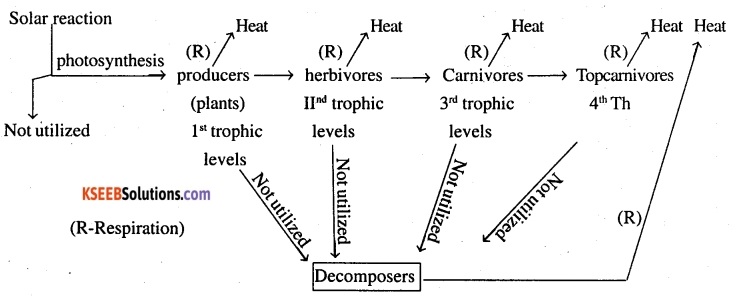You can Download Chapter 14 Ecosystem Questions and Answers, 2nd PUC Biology Question Bank with Answers, Karnataka State Board Solutions help you to revise complete Syllabus and score more marks in your examinations.
Karnataka 2nd PUC Biology Question Bank Chapter 14 Ecosystem
2nd PUC Biology Ecosystem NCERT Text Book Questions and Answers
Question 1.
Fill in the blanks.
(a) Plants are called as because they fix carbon dioxide.
(b) In an ecosystem dominated by trees, the pyramid (of numbers) is type.
(c) In aquatic ecosystems, the limiting factor for the productivity is
(d) Common detritivores in our ecosystem are
(e) The major reservoir of carbon on earth is
Answer:
(a) Producers
(b) Spindle
(c) light
(d) Earthworms ants and mites
(e) Oceanic.
Question 2.
Which one of the following has the largest population in a food chain?
(a) Producers
(b) Primary consumers
(c) Secondary consumers
(d) Decomposers
Answer:
(d) Decomposers can have maximum number but not included in food chain.
So (a) Producers is the answer.
![]()
Question 3.
The second trophic level in a lake is-
(a) Phytoplankton
(b) Zooplankton
(c) Benthos
(d) Fishes
Answer:
(b) Zooplankton
Question 4.
Secondary producers are
(a) Herbivores
(b) Producers
(c) Carnivores
(d) None of the above
Answer:
(a) Herbivores
Question 5.
What is the percentage of photosynthetically active radiation (PAR), in the incident solar radiation?
(a) 100%
(b) 50 %
(c) 1-5% .
(d) 2-10%
Answer:
(b) 50%.
Question 6.
Distinguish between
(a) Grazing food chain and detritus food chain
(b) Production and decomposition
(c) Upright and inverted pyramid
(d) Food chain and Food web
(e) Litter and detritus
(f) Primary and secondary productivity
Answer:
(a) Grazing food chain and detritus food chain
| Grazing food chain | Dertritus food chain |
| 1. Also known as Predator prey food chain. | 1. Also known as Saprotrophs food chain. |
| 2. It is a common food chain where producers are eaten by herbivores, herbivore by carnivore and the latter by higher-order carnivore. Eg: Grass→grass hopper → frog →Snake → Vulture. |
2. It proceedes from dead bodies and organic remains. Eg: Decaying plant matter → earth worm-) bird →Snake → Vulture. |
| 3. It binds the inorganic nutrients into organic matter. | 3. It releases the inorganic nutrients bound up in organic matter. |
| 4. It adds organic matter to dertritus food chain | 4. Provides inorganic nutrients to grazing food chain. |
(b) Production and decomposition
| Production | Decomposition |
| 1. It is the phenomenon of synthesis of fresh biomass. 2. It locks up inorganic nutrients into the biomass. 3. It traps energy. |
1. It is the phenomenon of degradation of waste organic matter. 2. It releases inorganic nutrients from the organic matter into the environment. 3. It releases energy. |
(c) Upright and inverted pyramid
| Up right pyramid | Inverted pyramid |
| It is the ecological pyramid where the producers form a broad base and the consumers keep decreasing (in energy number or biomoss) | It is the ecological pyramid, where the producers form a narrow base while the consumers keep increasing (in number of biomass) |
(d) Food chain and Food web
| Food chain | Food web |
| 1. Food chain refers to the transfer of energy from the producers through a series of organisms. 2. It is less realistic in nature |
1. A number of inter connected food chains constitute a food web. 2. It is more realisitc in nature. |
(e) Litter and detritus
| Litter | Detritus |
| 1. Freshly fallen parts of plants dead parts of plants,and animals and faecal matter of animals which haven’t straped to decompose, constitute litter. | 1. Freshly fallen and dead parts of plants and animals and faecal matter that have started to decompose constitute detritus. |
(f) Primary and secondary productivity
| Primary productivity | Secondary productivity |
| 1. It is rate at which matter is built up by producers. 2. It is due to photosynthesis 3. There is net gain if energy in the biosphere |
1. It is rate at which matter is built up by consumers. 2. It is due to herbiviores and predation. 3. There is no such activity |
Question 7.
Describe the components of an ecosystem.
Answer:
An ecosystem has two types of components biotic and abiotic.
(1) Biotic components:- There are living organisms present in an ecosystem. On the basis of their obtaining food, biotic components are of 3 types – produces, consumers and decomposers.
- Producers – They are autotrophic components that includes phytoplankton, some algae floating, submerged and marginal plants.
- The consumers are the organism like zooplankton, free swimming animals, bottom dwelling animals etc consumes producers as their food.
- The decomposers are organisms (saprophytic) which obtain nourishment from
organic remains they digest the organic remains by digestive enzyme and liberates inorganic nutrients. Because of this decomposers are called as mineralisers.
2. Abiotic components:- They are factors and materials of the physical environment. The materials include inorganic nutrients and organic remains. The organic remains consists of human substances, carbohydrate, lipide, proteins etc. The abiotic materials are air, water and soil.
![]()
Question 8.
Define ecological pyramids and describe with examples, pyramids of number and biomass.
Ans:
Ecological pyramids They are the graphical representations of various ecological parameter at the successive trophic levels of food chains with producers at the base top carnivores at the apex and intermediate levels .in between. Quantity at each level is indicated by length of bar in the graph. The pyramids are therefore also called bar diagrams.
Pyramids of number
It is graphical representation of numerical strength of various populations in different trophic levels per unit area of an ecosystem with producers forming base intermediate levels forming intermediate tiers and apex formed by top carnivores length of bar at each trophic level is proportional to the number of individuals at this level.
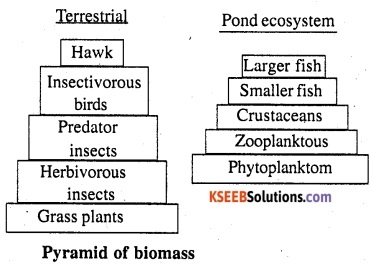
Pyramid of biomass
Biomass is the amount of living matter measured in terms of fresh or dry weight. Dry weight is preferred as it avoids seasonal variations in moisture content of biomass.
Pyramid of biomass is the graphical representation of amount of biomass per unit area sequence wise in rising trophic levels with producers at the base and top carnivores at the apex. Length of the bar indicates the comparative amount of biomass at that trophic level. Biomass, is maximum in producers. Only 10% to 20% biomass is passed from producer level to herbivore level.
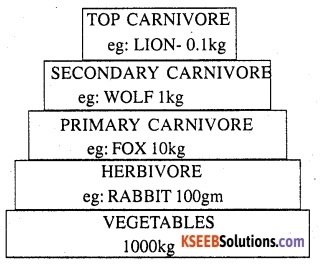
Question 9.
What is primary productivity? Give brief description of factors that affect primary productivity.
Answer:
Primary productivity:- It is the rate of synthesis of biomass by producers per unit time per unit area through, the process of photosynthesis.
Factors:- It depends up on sunlight, temperature moisture, nutrients and photosynthesis efficiency of producers.
(1) Sunlight:- In tropical regions maximum sunlight is available. It reduces towards the pole. Therefore more photosynthesis and high productivity occurs in tropics.
(2) Temperature:- Temperate forest have lesser productivity as compared to tropical forest due to cold climate during winter. Alpine and arctic regions have very low productivity because of low temperature almost through out the year.
(3) Moisture:- Good rain and humidity increase productivity of the ecosystem with the fall in availability of water the productivity decreases.
(4) Nutrients:- A regular availability of nutrients is required for sustaining plant growth and hence the productivity of an ecosystem.Coral reefs and esturies are highly productive as the nutrient supply is rich.
5. Photosynthetic efficiency:- Some plants are photosynthetically more efficient in trapping sunlight than others. eg: Sugarcane.
![]()
Question 10.
Define decomposition and describe the processes and products of decomposition.
Answer:
The process of physical and chemical breakdown of complex organic remains into inorganic raw materials (CO2, H2O, minerals) for recycling is called decomposition. It is carried out by organism remain are called detritus.
There are types decomposition process occurs.
(a) Fragmentation
(b) leaching and
(c) Catabolism
(a) Fragmentation of Detritus:- Small invertebrates animals called detritivores comes out in highly pulverised state in their faeces.
(b) Leaching:- Part of soluble substances present in the fragmented and decomposing detritus get leached to upper layers of soil by percolating water.
(c) Catabolism:- It is carried out by saprotrophic bacteria. They secrete digestive enzymes over the fragmented detritus. The enzymes change the complex organic compounds into Simple compounds.
Catabolic action forms two types of products- humus and inorganic the process involved in formation of these products are respectively called humification and mineralisation.
Question 11.
Give an account of energy flow in an ecosystem.
Answer:
Energy flow:- The passage of energy through various trophic levels of an ecosystem is called energy flow. Their is no circulation of energy. Instead unidirectional flow of energy occurs in the ecosystem.
(1) Capture of energy:- Under favorable conditions 1-5% solar radiations is captured by producers and used for photosynthesis. It is gross primary productivity some 20% this is used by producers in their own activities. The net primary productivity available to herbivores. 8-4% of incident radiations.
(2) Transfer to herbivores:- Herbivores get a part of net primary productivity. The remaining is changed into detritus which is a source of energy to decomposers. Herbivores waste a lot of food energy during ingestion about 30% food energy is used up by herbivores for their life activities and liberated as heated. The remaining is used in building biomass of herbivores. It is about 10% of productivity of producers. The transfer of about 10% of biomass energy from one tropic level to the next tropic level is called 10% law (ten percent law).
(3) Transfer to Primary carnivores:- Host of the herbivores are eaten by primary carnivores. A lots of energy wastage occurs during the predation. About 60% of assimilated food energy is used up by primary carnivores for their external activities. Rest amount of energy is transferred to Secondary carnivores.
(4) Transfer of energy to higher level carnivores:- 10% of biomass energy available at the level of primary carnivore becomes incorporated into biomass of secondary carnivores. If there is a still higher level carnivore, it uses 10% of biomass energy present at the level of secondary carnivores. As energy available at higher carnivore level becomes small, an ecosystem doesn’t have more than 3-5 trophic levels. eg….
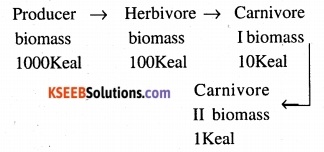
Question 12.
Write important features of a sedimentary cycle in an ecosystem.
Answer:
Sedimentary Biogeochemical cycle:- It is circulation of a biogeochemical between biotic and abiotic compound of an ecosystem is a nongaseous being lithosphere or sediments of the earth. Sedimentary cycles occur in case of phosphorus, calcium, magnesium, zinc, copper etc.
Important feature:
(i) Input of Nutrients:- Nutrients enter the nutrient pool through weathering of rocks. In sites soil formation also occur through weathering of rocks. Nutrients present in the soil become available to plants. Wind carries nutrients from mining areas and industrial area and deposited over the soil.
(ii) Internal nutrient cycling:- It is cycling or circulation of nutrients with in the ecosystem. Plants absorb nutrients from soil and incorporate them into organic matter. In the form of organic matter the nutrients pass from producers to herbivores and herbivores to carnivores. The process is called transfer. All trophic level pass a part of organic matter as detritus.
Detritus acted up on by decomposers and release the nutrients back into cycling pool. In stable ecosystems, over 80% of nutrient requirement of the biotic is met through internal nutrient cycling.
(iii) Out put of Nutrients:- It is a movement of nutrients out of an ecosystem. Out put reduces the availability of nutrients in the cycling pool. It occurs through soil erosion, run off water and economic out put like harvesting of crops or removal of wood from forest. Crop fields are always under negative nutrient budget.
![]()
Question 13.
Outline salient features of carbon cycling in an ecosystem.
Answer:
Carbon is the most abundant element as it occurs in every organic substances. It form 49% of the dry weight of organic matter. Carbon occurs as free carbon dioxide in atmosphere and dissolved as CO2 in hydrosphere. Carbon dioxide is being added to the cycling pool of atmosphere and hydrosphere through two processes, biological and non- biological
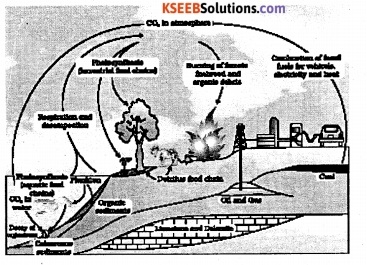
Biological- All living organisms produce carbon dioxide through respiration Carbon trapped in organic matter is released as CO2 during its decomposition.
Non Biological – Combustion or burning of biomass and fossil fuels produce carbon dioxides.

2nd PUC Biology Ecosystem Additional Questions and Answers
2nd PUC Biology Ecosystem One Mark Question
Question 1.
Define ecosystem.
Answer:
An ecosystem is a functional unit of nature, where living organisms (biotic) interact among themselves and also with the abiotic factors or their physical environment.
Question 2.
Give 2 man made ecosystem.
Answer:
Pond, crop fields
Question 3.
What is net primary productivity of an ecosystem. (CBSE Delhi 2005)
Ans:
It is the rate of energy stored or biomass accumulated by the producers. It depends up on rate of photosynthesis as well as respiration.
Question 4.
What PAR?
Answer:
The part of incident solar radiation that can be absorbed and used by plants autotrophs for photosynthesis, is called photosynthetically active radiation (PAR).
Question 5.
Name a dominant producers in a deep aquatic ecosystem. What other name could you give to a primary consumer, (AT 2007)
Answer:
Phytoplanktons or certain algae are the dominant producers in a deep aquatic ecosystem.
Primary consumers are known as herbivores.
Question 6.
What do the detritus food chain begin with?
Answer:
Detritus food chain begins with dead organic matters.
Question 7.
Why type of nutrition is shown by decomposers?
Answer:
Saprophytic nutrition.
Question 8.
What term is given to the inter connected food chain?
Answer:
Food-web.
![]()
Question 9.
What do mean by “Ten percent law”?
Answer:
Ten percent law states that only 10% of the energy is transferred from one trophic level to the next trophic level through food chain.
Question 10.
Identify the type of ecological pyramids shown here?
Answer:

- Pyramid of number in a tiee ecosystem.
- Pyramid of biomass in an aquatic ecosystem.
Question 11.
What do you mean by ecological succession?
Answer:
It is the phenomenon of gradual and fourly predictable changes in the species composition of a given area leading ultimately to the establishment of a climax community.
Question 12.
Define the term “Sere1
Answer:
The entire sequence of communities that successively change and lead to the establishment of a climax community is called a sere.
Question 13.
Define the term ‘climax community”?
Answer:
The community that is in near equilibrium with the environment, and does not undergo much change and occupied a large area is called climax community.
Question 14.
What do you mean by ‘Pioneer species’?
Ans:
The species that invades a bare area and starts establishing a community is called pioneer species.
Question 15.
Name the pioneer species
(1) On a bare rock
(2) In a water body (CBSE foreign 2008)
Answer:
- Lichen
- Phytoplankton.
Question 16.
What is the structure and composition of a community expected to remain unchanged.
Answer:
Un disturbed climax community
Question 17.
In the pyramid of biomass given below, name 2 types of crops
(i) One which is supported and
(ii) One which supports. In which ecosystem such type of pyramids found.

Answer:
(i) primary producer (phytoplankton)
(ii) primary consumer (zooplankton)
In aquatic ecosystem such type of pyramid found.
Question 18.
Give an example of an inverted ecological pyramid, what kind of pyramid of energy would it have?
Answer:
Inverted ecological Pyramid Pyramid of numbers based on large tree as a producer supporting a number of herbivorous birds each having a number a number of parasites.
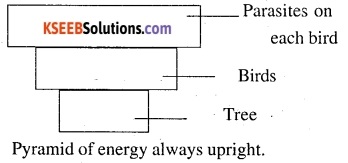
2nd PUC Biology Ecosystem Two Marks Questions
Question 1.
In the following table the ecological units are mentioned in the first coloumn vertically and their attributes are mentioned horizontally. Match the ecological unit and its attribute and put a tick mark in the blanks with the table
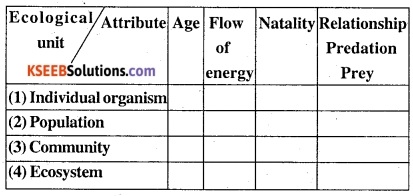
Answer:

Question 2.
Match the column A with any two of column B
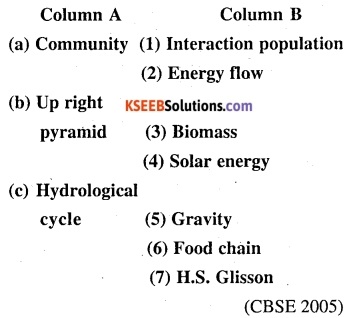
Answer:
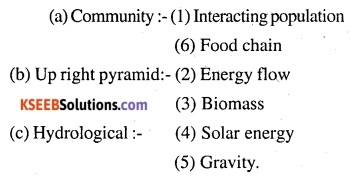
Question 3.
Differentiate between primary succession and secondary succession. (CBSE 2006)
Answer:
| Primary seccession | Secondary seccession |
| (1) It occurs in biologically sterile area. | (1) Occurs in an area which is biologically quite fertile |
| (2) Humus/organic matter is absent in the early stages | (2) Present from very begining. |
| (3) It begins on a soilless area. | (3) Occurs on a area having sufficient soil. |
| (4) It takes long time ie. 1000 years and more. | (4) It takes place in lesser time 50-200 years. |
Question 4.
Differentiate between standing crop and standing state (CBSE 2008)
Answer:
| Standing crop | Standing state |
| (1) It is the amount of living matter or biomass of biotic components of an ecosystem. | (1) It is the amount of inorganic nutrient present in an ecosystem. |
| (2) It is present all over the ecosystem. | (2) It occurs in the growth medium of producers. |
| (3) It indicates the productivity of the ecosystem. | (3) It determines the productivity of the ecosystem. |
Question 5.
Mention four functional aspects of in ecosystem.
Answer:
The four functional aspects of an ecosystem are
- Productivity
- Decomposition
- Energy flow
- Nutrient cycling.
Question 6.
Define Productivity? How is it expressed?
Answer:
Productivity refers to the rate of biomass production.
It is expressed as g-2 yr-2 or (Keal m-2) yr-1
Question 7.
Differentiate between Gross primary productivity and Net primary productivity.
Answer:
| Gross Primary productivity (GPP) | Net Primary productivity (NPP) |
| It is the rate of production of biomass/organic matter by producers during photosynthesis | It refers to the biomass or organic matter available at the producer level to the primary consumers i.e. GPP (Respiration losses) |
Question 8.
Write the factors which determine primary productivity.
Answer:
Primary productivity depends on
- The photosynthetic capacity of the plant species.
- Availability of nutrients
- Amount of sunlight available
- Water availability and temperature.
Question 9.
What would happen to the successive trophic levels in the pyramid of energy, if the rate of reproduction of phytoplanktons was slowed down? Suggestion in phytoplankton reproduction. (CBSE Delhi 2006)
Answer:
As phytoplanktons are the producers in the ecosystem, the amount of energy available for transfers will decrease. Organisms at successive trophic levels will also decrease. ‘
The two factors responsible for reduction in phytoplankton population are
- Low nutrients and
- Less availability of oxygen.
![]()
Question 10.
It is stated that the pyramid of energy is always upright. Justify (Delhi 2008)
Answer:
- The base of the pyramid of energy is occupied by producers, which have the maximum amount of energy.
- When energy flow from one trophic level only 10% is transferred, there is always loss of some energy in the form of heat.
- So, the amount of energy at higher trophic level will always be less than the lower trophic levels and pyramid of energy will be upright and be inverted.
Question 11.
Differentiate between Hydrarch succession and Xerarch succession
| Hydrarch succession | Xerarch succession |
| 1. The ecological succession that starts in water bodies and proceeds to mesic condition is called hydrarch succession 2. Phytoplantation form the pioneer community. |
1. The ecological succession, that starts With bare rocks xeric coditions and proceds to mesic condition is called Xerarch succession. 2. Lichens form the pioneer community. |
Question 12.
Why does the secondary succession is faster than primary succession.
Answer:
- Secondary succession occurs in an area or place where life had existed before, but had been some how wiped out.
- some soil and organic sediments are already present, hence succession is faster Primary succession occurs in an area where no life existed before. It takes time for the formation of soil and so succession takes more time.
Question 13.
Differentiate between carbon cycle and phosphorus cycle
Answer:
| Carbon cycle | Phosphorus Cycle |
| 1. The reservoir of carbon cycle is the atmosphere as carbon dioxide and also the lithosphere, as fossil fuel. 2. There is respiratory release of CO2 |
1. The reservoir of phosphorus cycle is the phosphate containing rocks of lithosphere 2. There is no respiratory release of phosphorus. |
Question 14.
Differentiate between production and decomposition
Answer:
| Production | Decomposition |
| 1. It is the process of the formation of biomass or organic matter from simpler inorganic substance 2. It occurs at the level of producers and consumers. |
1. It is the proses of the breakdown of larger organic molecules into simple molecules and ultimately into inorganic substances. 2. It occurs at the level of decomposers. |
Question 15.
Name the pioneer species on a bare rock. How do they help in establishing ?
Answer:
Lichens are the pioneer speciesin succession on a bare rock. The lichens secrete certain acids to corrode the rock and help in weathering of rocks and soil formation; thus they pave way to some plants like bryophytes. The climax community will be a mesic forest.
Question 16.
Differentiate between Gaseous and sedimentary cycle.
Answer:
| Gaseous cycle | Sedimentary Cycle |
| 1. The reservoir of gaseous cycle lies in the atmosphere 2. Exchange occurs in the form of gases between the living and nonliving components of the ecosystem. |
1. The reservoir of sedimentary cycle lies in the lithosphere 2. Exchange occurs mainly in the form of dissolved nutrients between the non-living and the living components. |
Question 17.
In the terrestrial ecosystem the detritus food chain (DFC) and the grazing good chain (GFC) become inter linked. Justify the above statement. What term is given to such interconnection? (HOTS)
Answer:
- Certain organisms of the GFC are predators to certain animals of DFC. As a result the food chains become interconnected.
eg. earth worms which are detrivores are eaten by small birds (DFC) which become prey to vultures/kites or even cats of the GFC. - Organisms like cockroaches and cows, which are omnivores play an important role in the interconnections of food chain constitute a food web.
2nd PUC Biology Ecosystem Three Marks Questions
Question 1.
Describe the factors that control decomposition ?
Answer:
Decomposition is controlled by
(i) Chemical composition of detritus
- Decomposition is faster when detritus is rich in nitrogen and water soluble substances like sugars.
- Decomposition is slow, when detritus is rich in lignin and chitin.
(ii) Temperature and soil moisture, through their effects on the activities of microbes.
- Warm and moist environment favour decomposition.
- Low temperature and absence/reduced moisture levels inhibits decomposition.
(iii) Oxygen
- Decomposition is an oxygen consuming process
- Anaerobic condition inhibits decomposition.
Question 2.
Represent schematically the decomposition cycle in a terrestrial ecosystem
Answer:
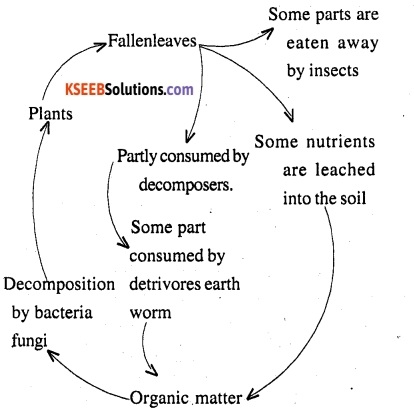
Question 3.
What is humus? Mention its properties.
Answer:
Humus is a dark coloured, amorphous substance produced by the process of humification during decomposition of detritus.
Properties of humus:-
- It is highly resistant to microbial action and under goes decomposition at an extremely slow rate.
- Being colloidal in nature, it serves as a reservoir of nutrients.
- It improves the water holding capacity of soil.
- Further decomposition of it provides inorganic nutrients to the plants.
Question 4.
A given species may occupy more than one trophic level in the same ecosystem at the same time. Explain with an example (2008)
Answer:
A snake eating a mouse in a field/lawn occupies the third trophic level in the food chain.
Plants → Mice → Snake
When the snake eats frog in the same field, it occupies the 4th trophic level in a food chain it is because the frog feeds on some of the insects which depends on the plants.
Plants → Insects → Frog → Snake
Thus in the same ecosystem one animal (snake) occupies more than one trophic level at the same time as it cannot satisfy its food need from one trophic level.
2nd PUC Biology Ecosystem Five Marks Question
Question 1.
(a) Mention 2 human activities that affect carbon cycle
(b) What are the different ways in which CO2 is added to the atmosphere ?
(c) How does the chemical nature of detritus determine the rate of decomposition.
Answer:
(a) The major human activities that influence carbon cycle are
- Burning of fossil fuels.
- Deforestation
(b) CO2 is added to the atmosphere in the following ways:
- Burning of fossil fuels
- Volcanic activity
- Forest fire
- Respiratory activities
(c)
- If the detritus is rich in lignin and chitin the decomposition is slow.
- If the detritus rich in nitrogen and water soluble substances like sugars, decomposition is faster.
Question 2.
Explain the different steps in the process of decomposition.
Answer:
- Fragmentation:- It is the process of breaking of the detritus into smaller particles by detrivores like earth worm.
- Leaching:- It is the process in which water soluble inorganic substances rundown into soil horizon and get precipitated as salts.
- Catabolism:- The enzymatic conversion of the detritus into simple organic compounds and then into inorganic compounds is called catabolism.
The enzymes are secreted by the decomposers like bacteria and fungal. - Humification:- Humification during decomposition leads to the accumulation of a dark coloured amorphous substance called, humus.
- Mineralisation:- It is the process in which the humus is degraded by certain micro organisms and the inorganic nutrients are released.
![]()
Question 3.
Describe the pond as an ecosystem.
Answer:
- A pond is a fairly self sustainable unit that shows even complex interactions of an aquatic ecosystem.
- It is a shallow water body in which all the major/basic components of an ecosystem are well exhibited.
The abiotic components include
- Water with all the dissolved inorganic and organic substances.
- The rich soil deposits at the bottom.
- The solar input.
- The cycle of day length and temperature
- Other elematic factors.
The biotic components include.
- The producers or autotrophic components that include phytoplanktons, some algae, floating, submerged and marginal plants.
- The consumers represented by zooplanktons free swimming animals, bottom dwelting animals etc.
Question 4.
Show schematically the energy flow through different trophic levels of an ecosystem.
Answer:
